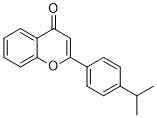MN-64 is a potent and selective inhibitor of Tankyrase 1 and 2 (IC50 = 6 and 72 nM, respectively). MN-64 inhibits Wnt signaling in HEK293 cells that have a reporter system for the Wnt pathway. Tankyrases are ADP-ribosyltransferases that are promising therapeutic targets for the treatment of cancer because they are involved in many cellular pathways, including the control of cell proliferation.
Physicochemical Properties
| Molecular Formula | C18H16O2 |
| Molecular Weight | 264.324 |
| Exact Mass | 264.115 |
| Elemental Analysis | C, 81.79; H, 6.10; O, 12.11 |
| CAS # | 92831-11-3 |
| Related CAS # | 92831-11-3 |
| PubChem CID | 2802462 |
| Appearance | Light yellow to yellow solid powder |
| Density | 1.152±0.06 g/cm3 (20 °C, 760 mmHg) |
| Boiling Point | 389.8±42.0 °C (760 mmHg) |
| Melting Point | 63-64 °C (ethanol) |
| LogP | 4.583 |
| Hydrogen Bond Donor Count | 0 |
| Hydrogen Bond Acceptor Count | 2 |
| Rotatable Bond Count | 2 |
| Heavy Atom Count | 20 |
| Complexity | 388 |
| Defined Atom Stereocenter Count | 0 |
| SMILES | O=C1C2C(=CC=CC=2)OC(C2C=CC(C(C)C)=CC=2)=C1 |
| InChi Key | PYTOHIUBXSJKQH-UHFFFAOYSA-N |
| InChi Code | InChI=1S/C18H16O2/c1-12(2)13-7-9-14(10-8-13)18-11-16(19)15-5-3-4-6-17(15)20-18/h3-12H,1-2H3 |
| Chemical Name | 2-(4-propan-2-ylphenyl)chromen-4-one |
| Synonyms | MN 64; MN-64; MN64 |
| HS Tariff Code | 2934.99.9001 |
| Storage |
Powder-20°C 3 years 4°C 2 years In solvent -80°C 6 months -20°C 1 month |
| Shipping Condition | Room temperature (This product is stable at ambient temperature for a few days during ordinary shipping and time spent in Customs) |
Biological Activity
| Targets | TNKS1 ( IC50 = 6 nM ); TNKS2 ( IC50 = 72 nM ); ARTD1 ( IC50 = 19.1 μM ); ARTD2 ( IC50 = 39.4 μM ) |
| ln Vitro | MN-64 is a potent inhibitor of tankyrase 1, with IC50 values for TNKS1, TNKS2, ARTD1, and ARTD2 of 6 nM, 72 nM, 19.1 μM, and 39.4 μM, respectively. MN-64 efficiently inhibits STF luciferase activity at 200 nM and Wnt/β-catenin at 1 μM[1]. |
| References |
[1]. Discovery of tankyrase inhibiting flavones with increased potency and isoenzyme selectivity. J Med Chem. 2013 Oct 24;56(20):7880-9. |
Solubility Data
| Solubility (In Vitro) |
DMSO: ~53 mg/mL (200.5~100 mM) Ethanol: ~53 mg/mL |
| Solubility (In Vivo) |
Solubility in Formulation 1: ≥ 2.5 mg/mL (9.46 mM) (saturation unknown) in 10% DMSO + 40% PEG300 + 5% Tween80 + 45% Saline (add these co-solvents sequentially from left to right, and one by one), clear solution. For example, if 1 mL of working solution is to be prepared, you can add 100 μL of 25.0 mg/mL clear DMSO stock solution to 400 μL PEG300 and mix evenly; then add 50 μL Tween-80 to the above solution and mix evenly; then add 450 μL normal saline to adjust the volume to 1 mL. Preparation of saline: Dissolve 0.9 g of sodium chloride in 100 mL ddH₂ O to obtain a clear solution. Solubility in Formulation 2: ≥ 2.5 mg/mL (9.46 mM) (saturation unknown) in 10% DMSO + 90% (20% SBE-β-CD in Saline) (add these co-solvents sequentially from left to right, and one by one), clear solution. For example, if 1 mL of working solution is to be prepared, you can add 100 μL of 25.0 mg/mL clear DMSO stock solution to 900 μL of 20% SBE-β-CD physiological saline solution and mix evenly. Preparation of 20% SBE-β-CD in Saline (4°C,1 week): Dissolve 2 g SBE-β-CD in 10 mL saline to obtain a clear solution. Solubility in Formulation 3: ≥ 2.5 mg/mL (9.46 mM) (saturation unknown) in 10% DMSO + 90% Corn Oil (add these co-solvents sequentially from left to right, and one by one), clear solution. For example, if 1 mL of working solution is to be prepared, you can add 100 μL of 25.0 mg/mL clear DMSO stock solution to 900 μL of corn oil and mix evenly. (Please use freshly prepared in vivo formulations for optimal results.) |
| Preparing Stock Solutions | 1 mg | 5 mg | 10 mg | |
| 1 mM | 3.7833 mL | 18.9165 mL | 37.8329 mL | |
| 5 mM | 0.7567 mL | 3.7833 mL | 7.5666 mL | |
| 10 mM | 0.3783 mL | 1.8916 mL | 3.7833 mL |
